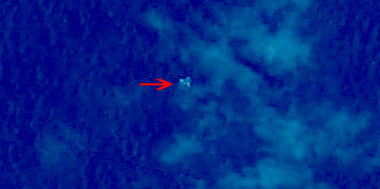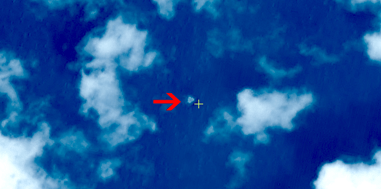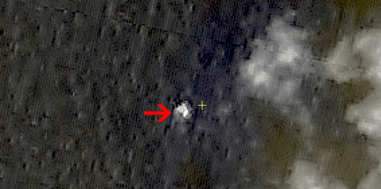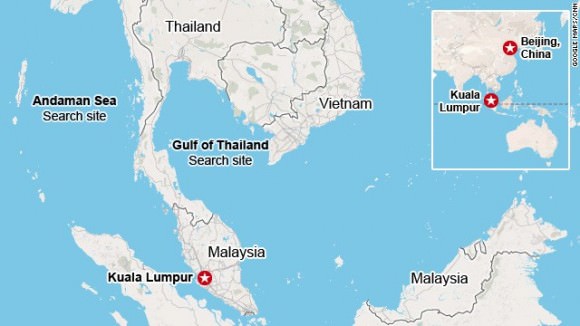Even more pictures from James Webb Space Telescope, China’s planning a mission to Neptune, SpaceX’s Booster 7 suffers from an explosion, black holes are messy eaters, going under Europa’s ice crust and more.
Continue reading “Booster 7’s BOOM, Nuclear Mission to Neptune, More JWST Images”BREAKING: Antares Rocket Explodes at Liftoff
Seconds after liftoff, Orbital Science’s Antares rocket exploded as it rose from the Mid-Atlantic Regional Spaceport at Wallops Island, Virginia. In video, the explosion appeared to come at the base of the rocket. The entire stack then fell back to the ground, with a second larger explosion.
According to NASA TV, there were no injuries reported at the launch site but there appears to be damage to the launch pad.
We’ll provide more information and updates as they become available. NASA and Orbital said they would be scheduling a news conference. Our Ken Kremer is on location at Wallops.
Photo of #Antares rocket exploding just after launch from @NASA_Wallops on Wallops Island, VA. Rocket unmanned. #nasa pic.twitter.com/3jMSYgp6mc
— Eduardo A. Encina (@EddieInTheYard) October 28, 2014
This is the first launch failure for NASA’s commercial space companies. Antares has had five successful launches. The launch was originally scheduled for Oct. 27 but was scrubbed when a boat entered restricted waters off the coast from the launch site.
The mission, was the third of eight Commercial Resupply Services missions that Orbital Sciences is under contract to NASA. The Cygnus capsule, named by Orbital the “SS Deke Slayton” after the late astronaut, was carrying 2,290 kilograms of cargo for the International Space Station.
This video was shot by journalist Matthew Travis at the press site at Wallops:
Chinese Satellites May Have Detected Debris from Missing Malaysia Airlines Flight

Chinese satellite image of suspected floating objects from the missing Malaysia Airlines plane MH 370. Credit: China SASTIND/China Resources Satellite Application Center
See more satellite imagery below[/caption]
Chinese government satellites orbiting Earth may have detected floating, crash related debris from the missing Malaysian Airline flight MH-370 that disappeared without a trace last week – and which could be a key finding in spurring the ongoing and so far fruitless search efforts.
Today, Wednesday, March 12, Chinese space officials released a trio of images that were taken by Chinese satellites on Sunday, March 9, showing the possible crash debris in the ocean waters between Malaysia and Vietnam.
China’s State Administration of Science, Technology and Industry for National Defence (SASTIND) posted the images on its website today, although they were taken on Sunday at about 11 a.m. Beijing local time.
I found the images today directly on SASTIND’s Chinese language website and they are shown here in their full resolution – above and below.
The Boeing 777-200ER jetliner went missing on Saturday on a flight en route from Kuala Lampur, Malaysia to Beijing, China.
The images appear to show “three floating objects in the suspected site of missing Malaysian plane,” according to SASTIND.

The plane carrying 227 passengers and 12 crew members mysteriously lost radio contact and vanished from radar while flying over the South China Sea. The transponder stopped sending signals.
And not a trace of the jetliner has been found despite days of searching by ships and planes combing a vast search area that expands every day.
Smaller versions of the satellites images and a video report have also been posted on China’s government run Xinhua and CCTV news agencies.
The three suspected floating objects measure 13 by 18 meters (43 by 59 feet), 14 by 19 meters (46 by 62 feet) and 24 by 22 meters (79 feet by 72 feet).

These suspected debris are surprising large, about the size of the jetliners wing, according to commentators speaking tonight on NBC News and CNN.
SASTIND said that “the three suspected objects were monitored at 6.7 degrees north latitude and 105.63 degrees east longitude, spreading across an area with a radius of 20 kilometers, according to Xinhua.
These coordinates correspond with the ocean waters between Malaysia and Vietnam, near the expected flight path.
“Some 10 Chinese satellites have been used to help the search and rescue operation,” reported CCTV.

China, the US, Malaysia and more than a dozen counties are engaged in the continuing search and rescue effort that has yielded few clues and no answers for the loved ones of the missing passengers and crew on board. Our hearts and prayers go out to them.
The search area currently encompasses over 35,000 nautical square miles.
Ships and planes are being dispatched to the location shown by the new satellite imagery to help focus the search effort and find the black boxes recording all the critical engineering data and cockpit voices of the pilot and copilot and aid investigators as to what happened.
No one knows at this time why the Malaysia Airlines flight mysteriously disappeared.
Breaking News – Controversial North Korean Rocket Launch Apparently Fails in Flight

[/caption]
North Korea has just gone ahead with their announced intentions to defy international warnings and launched the highly controversial Unha-3 long range missile a short while ago at 7:39 AM local time on Friday the 13th (2239 GMT, 6:39 PM EDT Thursday), as reported by CNN, NBC, Fox and other news media on live TV broadcasts at 7 PM EDT, Thursday evening. [Story Updated]
The 3 stage rocket apparently failed in flight quickly and broke apart within the first 90 seconds to 2 minutes and never reached orbit, according to US, Japanese and South Korean officials who have been closely monitoring the developing situation the past few weeks.
Missile tests by North Korea are banned by UN Security Council resolutions.
The White House is expected to issue a statement shortly. Read the official NORAD statement below.
North Korean had invited news media from around the world to view the rocket up close at the launch pad a few days ago, an unprecedented action of openness. But the actual launch and exact timing was not announced ahead of time.
The international reporters who had gathered for the event were caught off guard, in the North Korean capital of Pyongyang, many hundreds of miles distant from the launch site.
The failure is a huge embarrassment to the prestige of the North Korea’s new leader, 28 year old Kim Jong Un, who was promoted to the leadership upon the recent death of his father Kim Jong Il.
Japanese Defense Ministry officials are quoted by NBC and CNN as saying the rocket fell into the ocean after flying about 75 miles. The cause of the rocket failure is not known at this time.
Animation of the planned Unha-3 rocket launch. Credit: Analytical Graphics, Inc. (AGI)
North Korea’s neighbors and the West had strongly condemned North Korean’s launch plans saying this launch was really a disguised test of a military ballistic missile that could be easily converted for military purposes and strike as far as the US West Coast with a nuclear warhead.
North Korean said they were merely launching a small and peaceful experimental weather satellite which they displayed to the media days ago. The timing coincides with the anniversary of the 100th birthday of Kim Il Sung, deceased founding father and former leader of North Korea
The Unha-3 rocket blasted off from the Tongchang-ri, rocket base on North Korea’s west coast near the Chinese border on a southerly course. The trajectory was aimed to skirt along the coasts of South Korea and Japan, causing those countries great concern if the rocket were to develop problems in flight and veer off course and crash on land, potentially causing damage or loss of life in a worst case scenario.
The 90 ton Unha-3 rocket is about 100 feet (30 m) tall.
The UN Security council has scheduled an emergency meeting on Friday in New York to deal with the situation.
There has been no official announcement from the North Korean Government as of this writing.
Further details will be added here as this breaking news story unfolds
—–
NORAD released the following statement this evening April 12, 2012
“North American Aerospace Defense Command (NORAD) and U.S. Northern Command officials acknowledged today that U.S. systems detected and tracked a launch of the North Korean Taepo Dong-2 missile at 6:39 p.m. EDT. The missile was tracked on a southerly launch over the Yellow Sea.”
“Initial indications are that the first stage of the missile fell into the sea 165 km west of Seoul, South Korea. The remaining stages were assessed to have failed and no debris fell on land. At no time were the missile or the resultant debris a threat.”
Rep. Giffords, Wife of NASA Astronaut, Shot
[/caption]
Rep. Gabrielle Giffords of Arizona was shot in the head Saturday when an assailant opened fire outside a grocery store during a meeting with constituents, killing at least five people and wounding several others. Giffords is the wife of NASA astronaut Mark Kelly who is scheduled to command one of the last space shuttle missions. Giffords is reportedly in stable condition. Those killed included a 9-year-old child and a federal judge.
Kelly is scheduled to command the shuttle Endeavour in April, but he immediately flew on a NASA jet to Tucson from Houston, officials said, and asked to be put on personal leave. His twin brother Scott is now on board the International Space Station as commander. NASA officials said Scott Kelly was informed of the shooting by flight controllers at the Johnson Space Center.
Reports say the gunman shot Giffords from about a foot away, and then opened fire on the rest of the crowd. The gunman was subdued by other members of the crowd and is now in custody.
The surgeon who attended Giffords said the bullet traveled all the way through her head, but he is optimistic about her recovery.
NASA Administrator Charlie Bolden issued a statement on the tragedy:
“We at NASA are deeply shocked and saddened by the senseless shooting of Representative Giffords and others at Saturday’s public event in Tucson. As a long-time supporter of NASA, Representative Giffords not only has made lasting contributions to our country, but is a strong advocate for the nation’s space program and a member of the NASA family. She also is a personal friend with whom I have had the great honor of working. We at NASA mourn this tragedy and our thoughts and prayers go out to Congresswoman Giffords, her husband Mark Kelly, their family, and the families and friends of all who perished or were injured in this terrible tragedy.”
Sources: AP, Twitter
Breaking News: Small NEO Could Pass Within 60,000 km of Earth on Tuesday
[/caption]
A small asteroid will likely pass very close to Earth this week Tuesday. Astronomers are still tracking the object, now designated as 2010 TD54, and various estimates say it could possibly come within anywhere from 52,000 km (33,000 miles) to 64,000 km (40,000 miles) on October 12, with closest approach at approximately 11:25 UT. Information on the IAU Minor Planet Center website lists the object as coming with 0.0003 AU. The size of the object has not been determined, but estimates say it is likely smaller than 10 meters. We’ll provide an update as soon as more information is available.
UPDATE: Don Yeomans, Manager of NASA’s Near-Earth Object Program Office replied to an inquiry about the object and said the newly discovered NEO 2010 TD54 is approximately 5-10 meters in size, and is now predicted to pass about 46,000 km from Earth’s surface at about 07:25 EDT (11:25 UT) on Tuesday, Oct 12, 2010. It was discovered by Catalina Sky Survey on Saturday morning.
“Only 1 in a million chance of an impact,” Yeomans said, “and even if it does impact, it is not large enough to make it through the Earth’s atmosphere to cause ground damage.”
The object may be visible to amateur telescopes as a 14th magnitude “star” — it will be traveling through the constellations Pisces and Aquarius.
Sources: IAU Minor Planet Center, Unmanned Spaceflight,Yahoo News Groups




